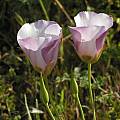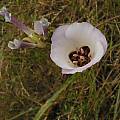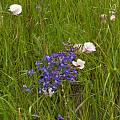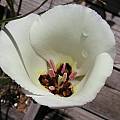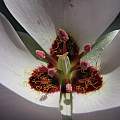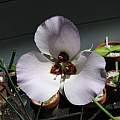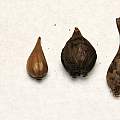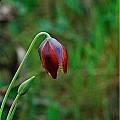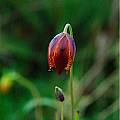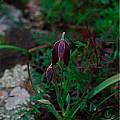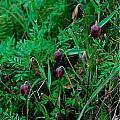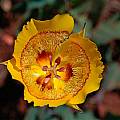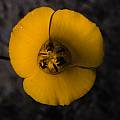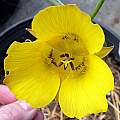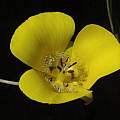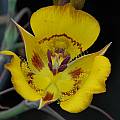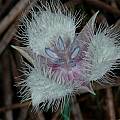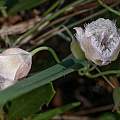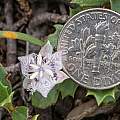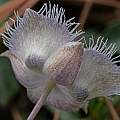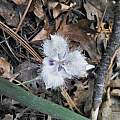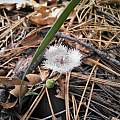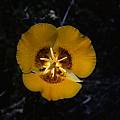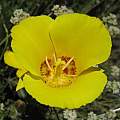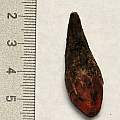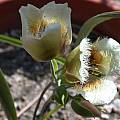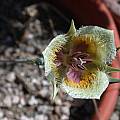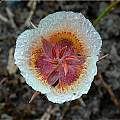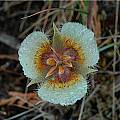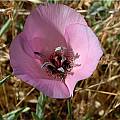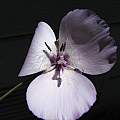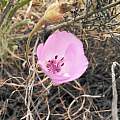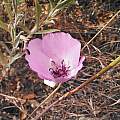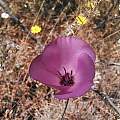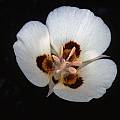Calochortus is a genus in the Liliaceae family with species distributed in western North America, Mexico, and south to Guatemala. The greatest concentration of species is found in California. Three good sources of information are Frank Callahan, The Genus Calochortus, in McGary, 2001 found listed in References, Calochortus, Gerritsen and Parsons, 2007 found listed in References, and Mariposa, the newsletter of the Calochortus Society, a quarterly issued between 1989 and 2005. Calochortus species starting with c and ending with d are found on this page
Calochortus species a-b - Calochortus species e-lo - Calochortus species lu-n - Calochortus species o-r - Calochortus species s - Calochortus species t-u - Calochortus species v-z - Calochortus hybrids - Calochortus index
Calochortus catalinae S.Watson is found in grassy places near the coast from southern California to Baja, growing to about 60 cm high. The flowers are large, white to lilac, usually with a purple spot at the base of each petal. Petals are naked except for a few slender hairs near the base. This species was featured in Mariposa,Volume 13,#4. This species was seen April 2005 growing on Figueroa Mountain in Santa Barbara county in grassy areas along with Lupinus sp., Delphinium parryi and Dipterostemon capitatus (syn. Dichelostemma capitatum). These in situ photos were taken there by Mary Sue Ittner.
Photo #1 is of plant grown from seed photographed by Bob Rutemoeller. Photos 2-5 were taken by Nhu Nguyen. Photo 5 shows the bulbs.
Calochortus cernuus Painter is a Mexican species in the Cyclobothra section of Calochortus, subsection Purpurei. This species has erect, straight 20-40 cm glaucous stems that are sometimes branched, with nodding flowers held on on slender peduncles. This species is known only from the Sierra de Tepoxtlan (2000-2800 m) in the state of Morelos, Mexico. Where it occurs, it can be locally abundant. The photos were taken in September of 2007 in two locations: in a volcanic area near the cuota and on the tops of the "knobs" of Tepoxtlan. Photos by Mary Gerritsen
Calochortus clavatus S.Watson see the Calochortus clavatus page.
Representative photos of this species. Photo 1 was taken by Mary Gerritsen, photo 2-3 were by Ron Parsons, photo 4 by Susan Hayek, photo 5 was by Bob Rutemoeller and photo 6 by Mary Sue Ittner.
Calochortus coeruleus (Kellogg) S.Watson is one of the "Cat's Ear" calochortus, and the photo below clearly illustrates the resemblance to the inner surface of a Cat's ear. This is a small species (15 cm tall), although we have seen up to 18 flowers on an individual stem, which makes it quite charming when you get down to the ground and take a close look at this little beauty. This species is found in Northern California and is usually found in partial shade among grasses in meadows and in small clearings under trees at elevations of 900-2500 m. This species was featured in Mariposa,Volume 13,#2. The photo below was taken in mid July, 2006 near Castle Crags State Park, California. The first photo by Mary Gerritsen. The next three photos from Calflora were taken by John L. Thompson June 2021 in Shasta and Tehama counties and shared under a CC BY-NC license.
Excerpts and photos from Kipp McMichael's "Calochortus pursuits":
"We left the relatively towering stands of C. clavatus var avius for a nearby "lava cap" habitat where an ancient volcanic ash deposit had hardened and weathered into a distinctive, nutrient-limited soil type. As is commonly the case in such places, geophytes were common and in addition to Brodiaea, Bloomeria and Fritillaria we also found a few small plants of Calochortus coeruleus near the southern limits of its range."
Calochortus concolor (Baker) Purdy & L.H.Bailey is a golden species with erect, commonly branched stems 20-60 cm, that can carry one to eight bowl-shaped flowers. This species is found from the San Bernardino Mountains of California, south to the north Sierra Juarez in northern Baja Mexico. It grows in grasslands, chaparral, edges of coniferous forest, and in the desert mountains amongst the grasses, sagebrush, cacti and agave, elevations 600-2600 m. Photo #1 was taken by Ron Parsons, Riverside County, California. Photo 2 was taken by Jim Duggan. Photo 3 taken by Nhu Nguyen shows a bulb.
Calochortus coxii M.R.Godfrey & Callahan is endemic to one ridge complex south of Roseburg and north of Myrtle Creek in Oregon. A short-stemmed plant (30 cm) with flowers that remain cup-shaped, it inhabits ultramafic (serpentine) soils in nature, but despite Callahan's (2001:113) suggestion that Epsom salts be added to its soil, the pictured plants are growing well without this amendment, in a bulb frame in northern Oregon. This species was featured in Mariposa,Volume 12,#1. The first two photos by Jane McGary. Numbers three and four shown below were taken at the site of the type collection, June 2007 by Mary Gerritsen
Calochortus davidsonianus Abrams is currently classified as a form of Calochortus splendens, although it may well be a separate taxon. This form has more open flowers, short hairs near the rounded gland, non-bulbiferous stems and is often found in grassy meadows. This species was featured in Mariposa,Volume 15,#1. Height range: 20-60 cm. Photo 1 by Mary Gerritsen was taken in late May at the top of Walker Ridge, east of Clear Lake, California. Photo #2 was taken by Nhu Nguyen of a plant in cultivation.
Excerpts and photos from Kipp McMichael's "Calochortus pursuits":
"From the old cowboy movie set terrain of Soledad Canyon, we headed south toward the hills northeast of Temecula, CA to a colony of Calochortus I had visited long after the blooming season in 2014. Given the area and the herbarium info I could find, I had thought this was a population of Calochortus weedi (either var weedi or var intermedius). We arrived at the access road into the National Forest to discover the gate had been closed to prevent vehicle access while a storm front moved through the area over the weekend. We were left with a decision: Hike the 2.5 miles along the road to the population or give up and move on to our next destination. We stayed true to the cause and headed off on foot to the ridgetop locality. We were still a few feet from the car when we saw the first of the Calochortus davidsonianus. We would see hundreds of these plants, mostly in seed, on our way to the locality. When we arrived, I discovered that what I had thought was a colony of mostly C. weedi was in fact a large colony of Calochortus davidsonianus. Although not a banner year, the plants here were nonetheless quite common and most had maturing capsules."
"In a return to morning trips close to Berkeley, I set my sites on stands of "Calochortus splendens" growing in serpentine soils in east Lake County. I use the name in quotes because, from my experience in the field, there are 2 different taxa contained with the official species Calochortus splendens. The previously mentioned Calochortus davidsonianus is the distinct morphotype of C. splendens that grows in southern California. Intriguingly, the supposed Calochortus splendens that grows in northern California looks much more like Calochortus davidsonianus from southern California than it does the Calochortus splendens from areas between southern California and the Bay Area. I therefore call this taxa [photographed below] Calochortus davidsonianus."
Calochortus dunnii Purdy, the smallest species of Section Mariposa, has slender, often branched stems bearing from two to eight upright, open bell-shaped flowers. This species is found in the Vulcan Mountains of San Diego County, California, south into the Guadalupe Mountains of Baja California. Height: to about 60 cm tall. The photo below was taken in situ in San Diego County California. Photo by Ron Parsons.
Calochortus species a-b - Calochortus species e-lo - Calochortus species lu-n - Calochortus species o-r - Calochortus species s - Calochortus species t-u - Calochortus species v-z - Calochortus hybrids - Calochortus index
